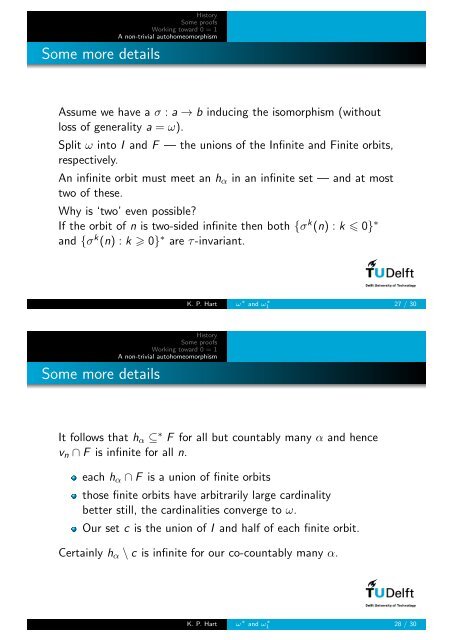* and 1* - Quidquid latine dictum sit, altum videtur - TU Delft
* and 1* - Quidquid latine dictum sit, altum videtur - TU Delft
* and 1* - Quidquid latine dictum sit, altum videtur - TU Delft
You also want an ePaper? Increase the reach of your titles
YUMPU automatically turns print PDFs into web optimized ePapers that Google loves.
History<br />
Some proofs<br />
Working toward 0 = 1<br />
A non-trivial autohomeomorphism<br />
Some more details<br />
Assume we have a σ : a → b inducing the isomorphism (without<br />
loss of generality a = ω).<br />
Split ω into I <strong>and</strong> F — the unions of the Infinite <strong>and</strong> Finite orbits,<br />
respectively.<br />
An infinite orbit must meet an hα in an infinite set — <strong>and</strong> at most<br />
two of these.<br />
Why is ‘two’ even possible?<br />
If the orbit of n is two-sided infinite then both {σ k (n) : k 0} ∗<br />
<strong>and</strong> {σ k (n) : k 0} ∗ are τ-invariant.<br />
History<br />
Some proofs<br />
Working toward 0 = 1<br />
A non-trivial autohomeomorphism<br />
Some more details<br />
K. P. Hart ω ∗ <strong>and</strong> ω ∗ 1 27 / 30<br />
It follows that hα ⊆ ∗ F for all but countably many α <strong>and</strong> hence<br />
vn ∩ F is infinite for all n.<br />
each hα ∩ F is a union of finite orbits<br />
those finite orbits have arbitrarily large cardinality<br />
better still, the cardinalities converge to ω.<br />
Our set c is the union of I <strong>and</strong> half of each finite orbit.<br />
Certainly hα \ c is infinite for our co-countably many α.<br />
K. P. Hart ω ∗ <strong>and</strong> ω ∗ 1 28 / 30


